- Practical, classy, well thought out and comfortable interior
- Generous standard equipment list
- Unique hybrid drivetrain delivers EV-like acceleration and power
- Not as efficient as traditional hybrids
- Servicing is a bit expensive
- Driving dynamics on the softer side
It’s hard to find an automobile combination more popular at the moment in Australia than a mid-size hybrid SUV – despite this, buyers haven’t had a lot of choice 0- up until now, it’s pretty much been the prolific Toyota Rav4 hybrid, the Haval H6 hybrid or the Subaru Forester Hybrid – though the former is the one that has constantly set the sales charts alight. We’ve been fairly puzzled that despite the instant success off Toyota’s midsized hybrid offering back in 2019 that other brands have been so slow off the mark to offer alternatives. For this reason, we were excited to hear that that Nissan’s new generation X-Trail would offer a hybrid drivetrain to give the RAV4 some good competition – we spent a week behind the wheel of a 2023 Nissan X-Trail Ti-L e-Power Hybrid to see how Nissan’s Hybrid attempt stacks up.
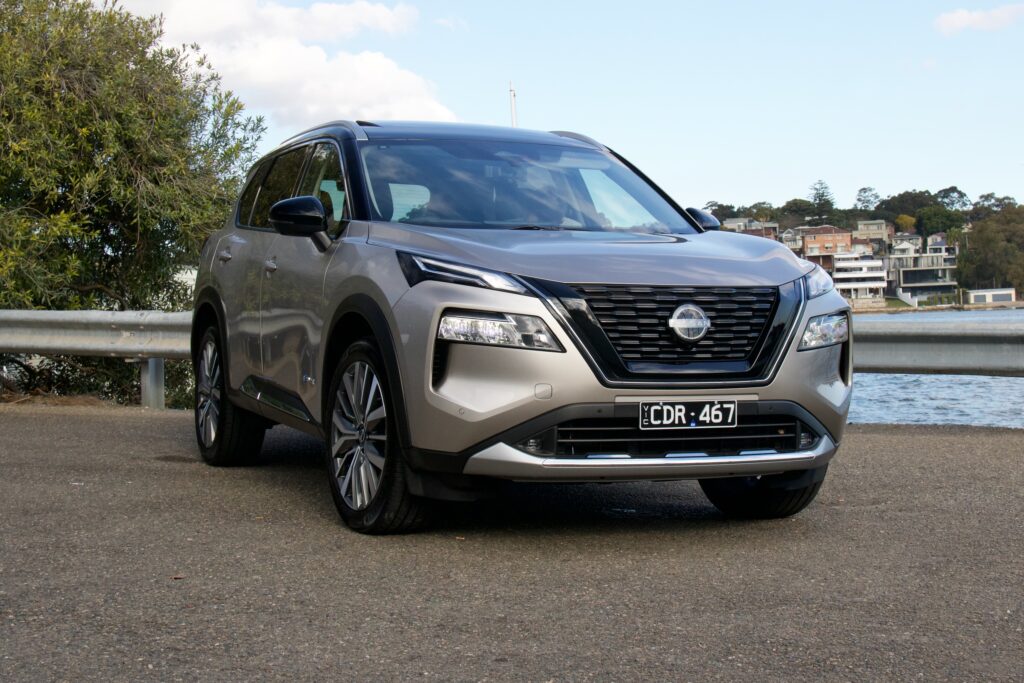
The X-Trail has been a successful nameplate in Australia through it’s first three generations, with the first two being more rugged and boxier in design with more of an off-road focus and the third generation opting for a more curvaceous crossover look, and a definite suburban focus – perhaps loosing a bit of it’s charm in the process. We were impressed with the petrol X-Trail that we tested earlier in the year – so does Nissan’s e-Power drivetrain make Nissan’s mid-size SUV even more compelling against a very croweded market? Read on to find out.
Price & Equipment: 9.0/10
The 2023 X-Trail range kicks off at around $40,100 drive-away (depending on location) for the base petrol ST variant, with the least expensive hybrid model being the ST-L e-Power which starts at around $55,000 drive away (depending on location). The Ti-L e-Power Hybrid variant we tested, with premium paint is picked at around $63,100 drive away (depending on location).
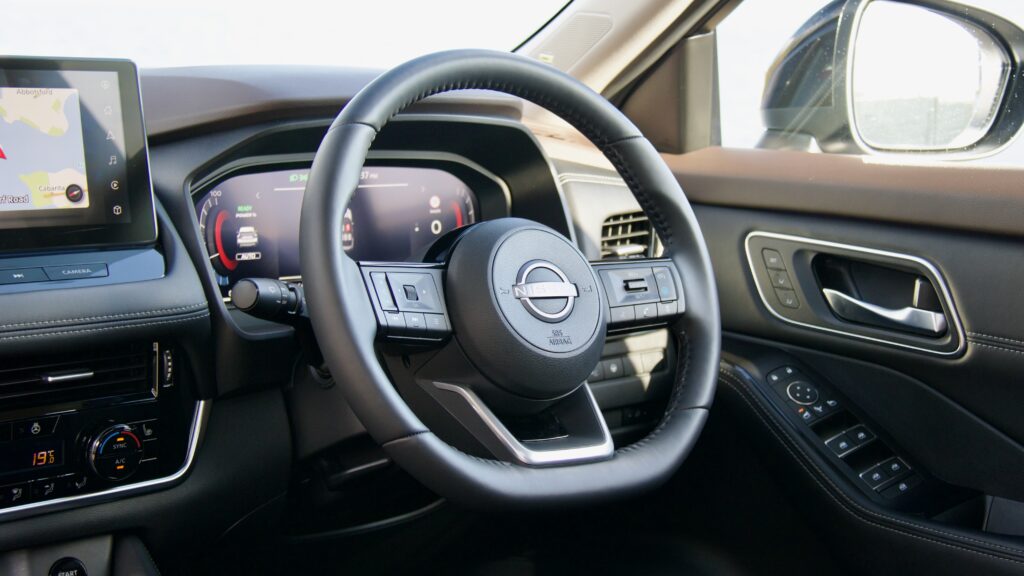
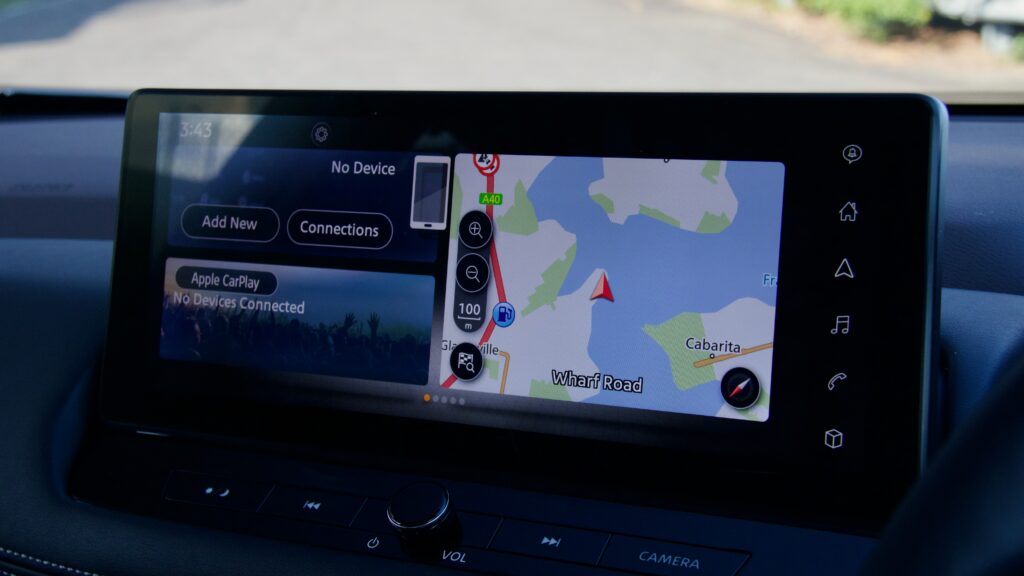
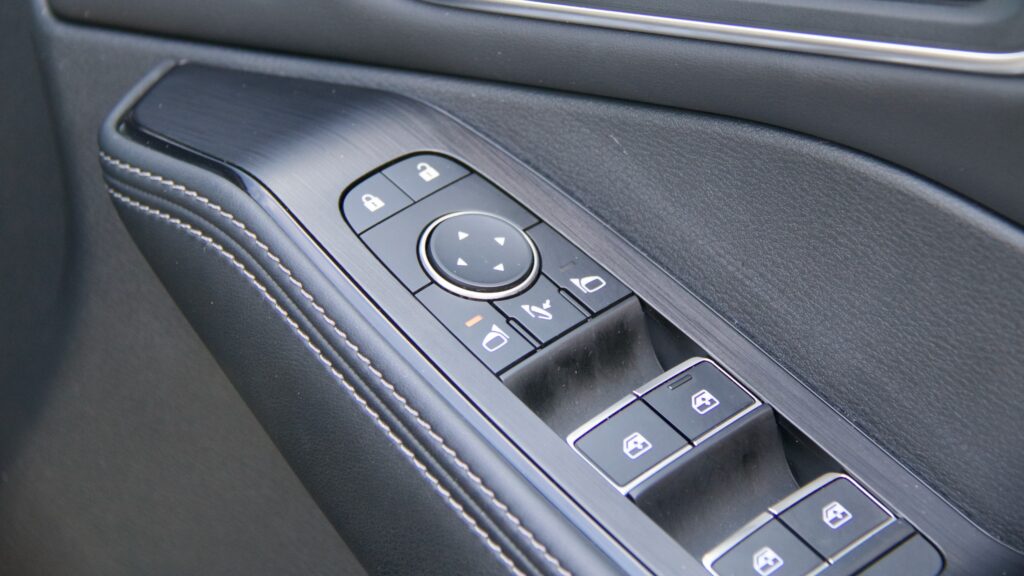
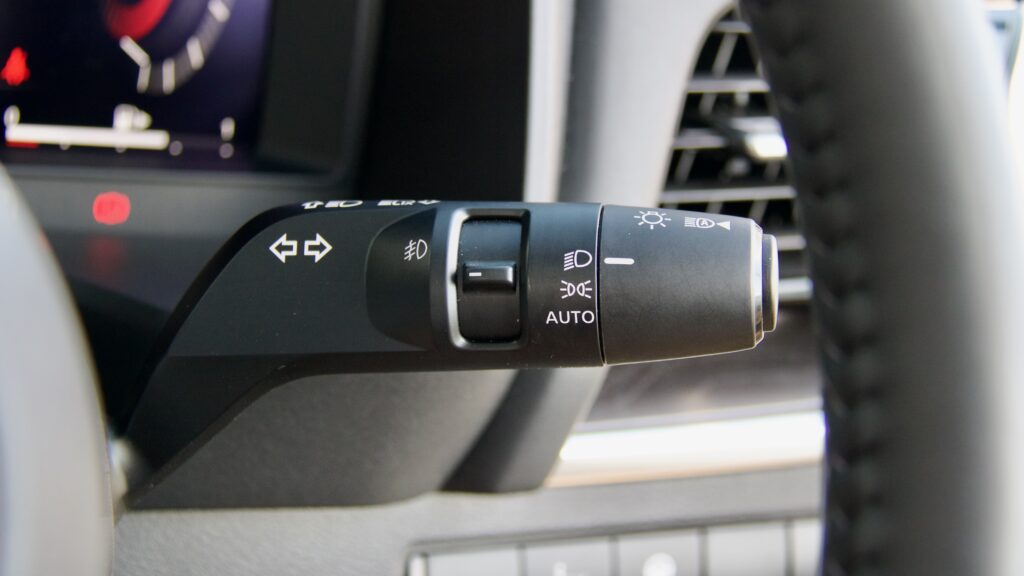
2023 Nissan X-Trail Ti-L e-Power Hybrid standard equipment:
- 20-inch alloy wheels
- Dusk-sensing automatic adaptive LED headlights
- LED front daytime running lights
- LED fog lights
- Automatic rain-sensing front wipers
- 12.3-inch digital instrument cluster
- 10.8-inch heads-up display head-up display
- Digital rear-view mirror
- Tri-zone climate control
- Keyless entry and push-button start
- Remote engine start
- Driver’s seat and mirror memory
- Auto-folding and heated side mirrors with tilt in reverse
- Nappa leather-trimmed interior
- Heated front seats and outbound rear seats
- Leather heated steering wheel
- Ambient interior lighting
- 10-way electric adjustment for the driver and front passenger seats
- Panoramic sunroof
- Rear door shades
- Powered tailgate with kick sensor
- 12.3-inch touchscreen
- Wireless Apple CarPlay and wired Android Auto
- AM/FM/DAB+ radio
- Wireless phone charger
- Bose 10-speaker sound system
- 4x USB charging points (2x front, 2x rear)
- Active noise cancellation
Safety equipment:
Featuring a five-star ANCAP rating awarded in 2021, the X-Trail features a fairly comprehensive safety package including:
- Seven airbags (front driver and passenger, front side driver and passenger, front centre airbag, and side curtain airbags)
- Reversing camera
- 360-degree camera
- Front and rear parking sensors
- Autonomous Emergency Braking (AEB) with pedestrian and cyclist detection
- Front and rear-cross traffic alert
- Rear auto braking
- Blind-spot warning
- Lane departure alert with assistance
- Driver attention monitoring
- Traffic sign recognition
- Radar cruise control
- Tyre pressure monitoring system
- Adaptive auto high beam
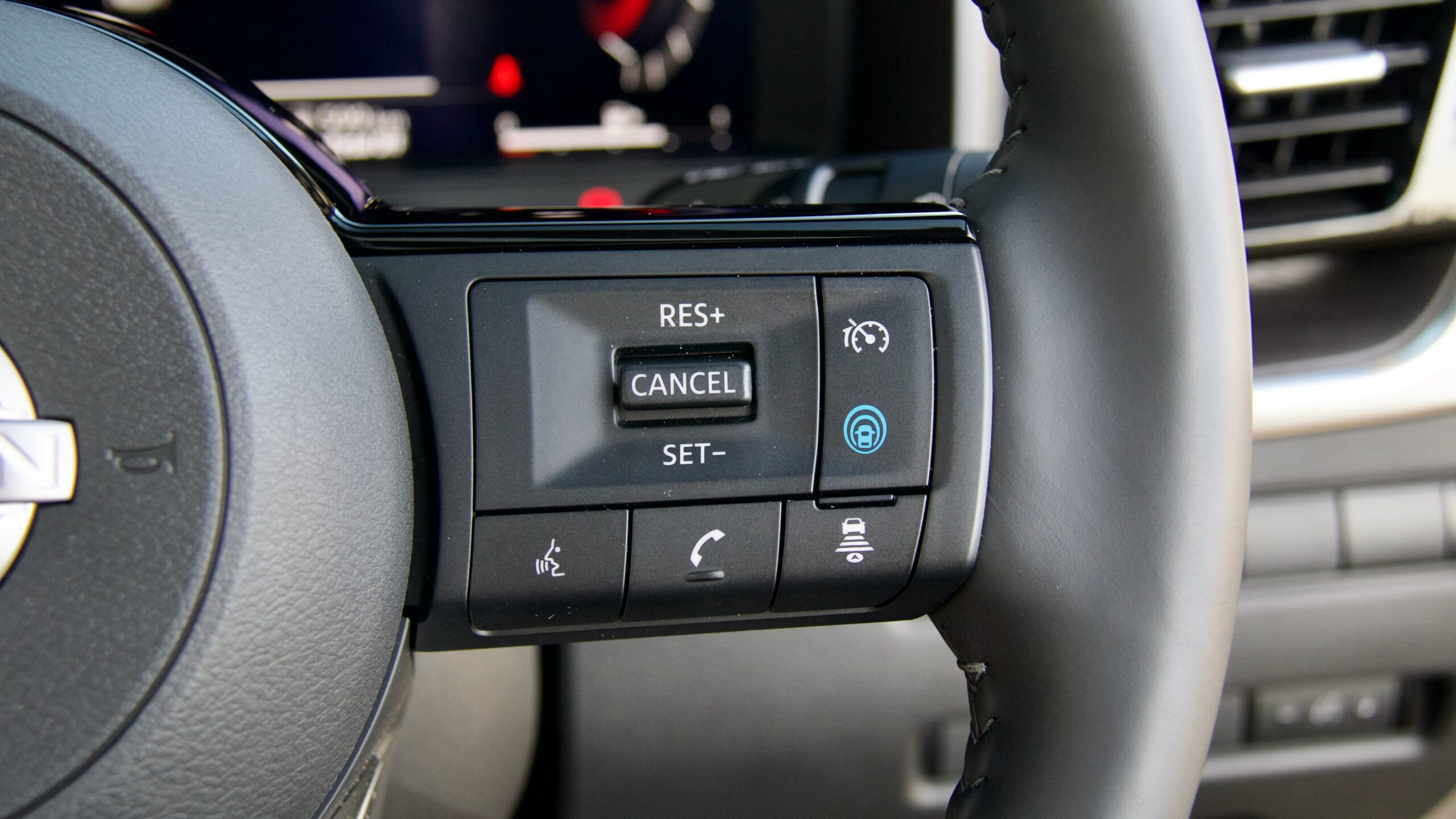
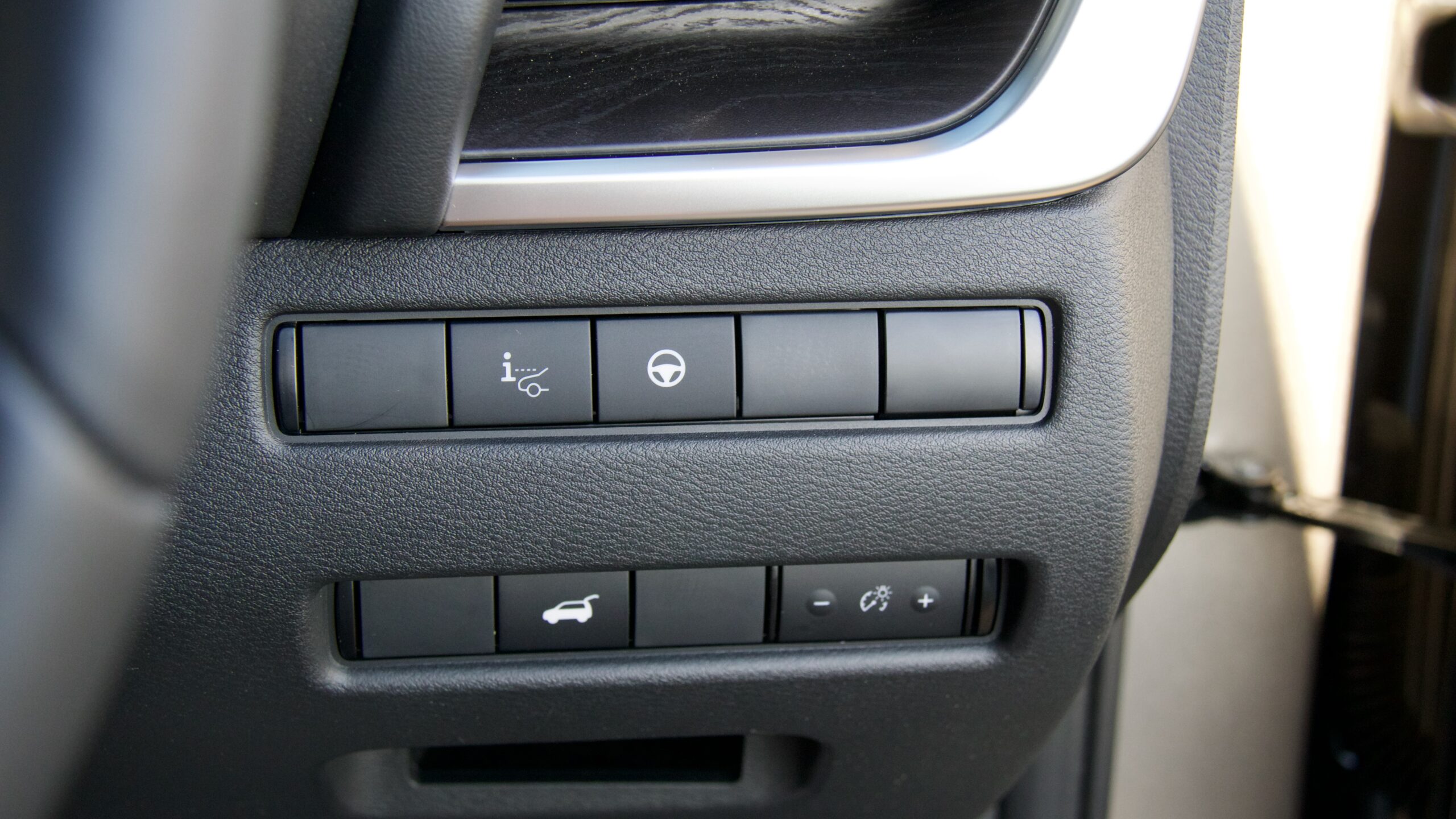
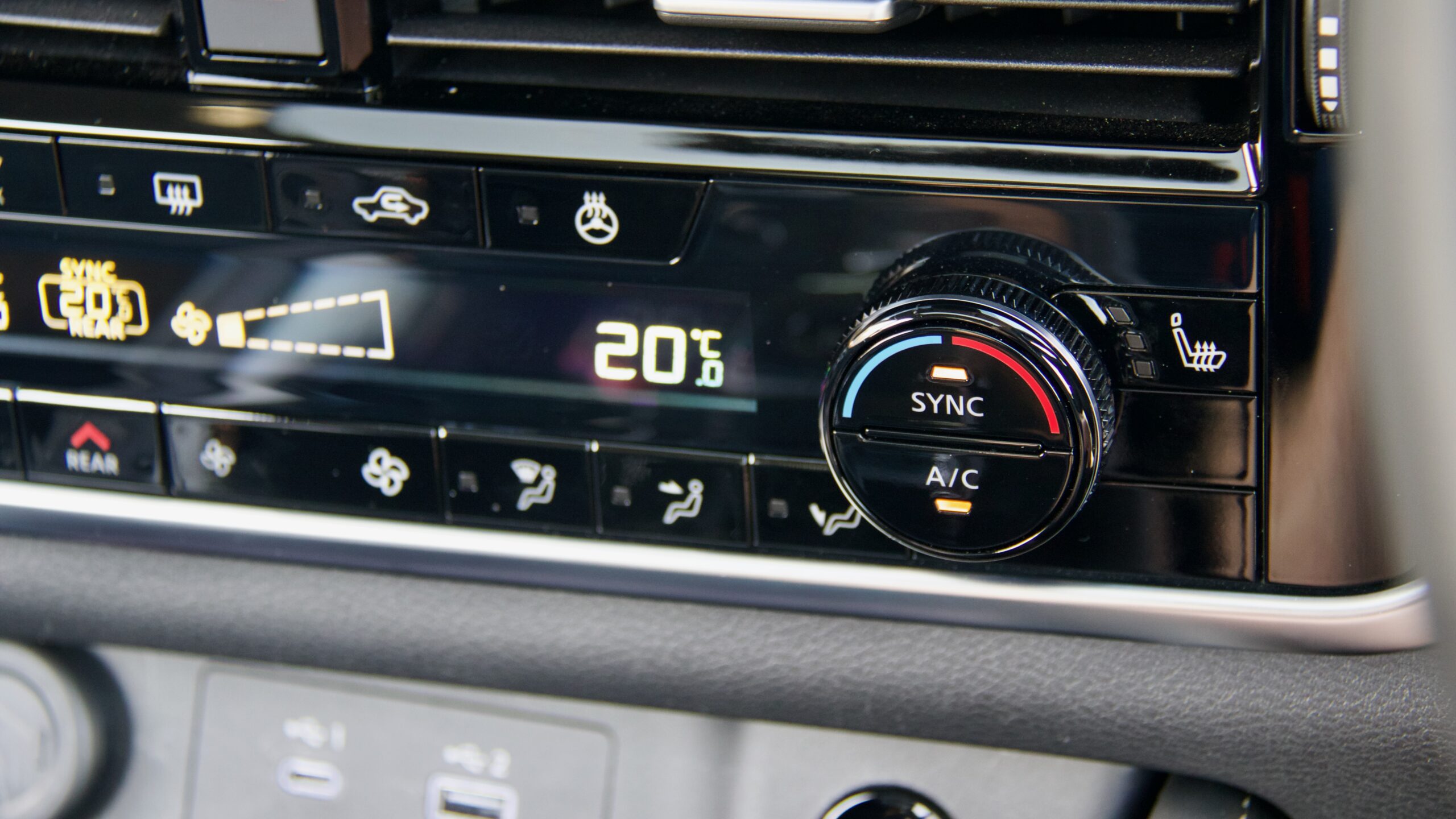
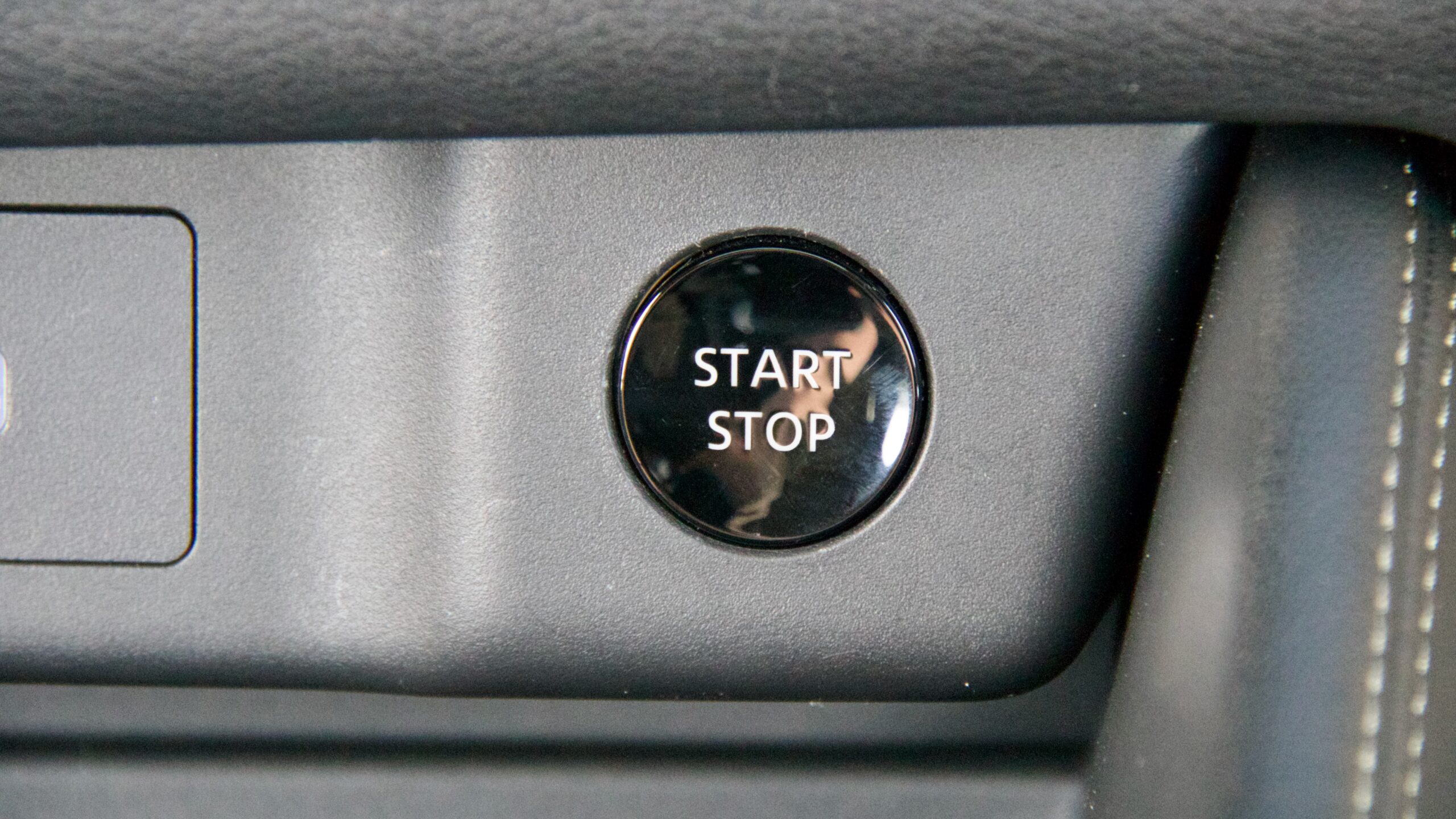
Options for the 2023 Nissan X-Trail Ti-L e-Power Hybrid:
Buyers can opt for either a black Nappa leather-accented interior or a tan Nappa leather-accented interior, both of which are no cost options. The only other option Nissan offers for the X-Trail, is a choice of colour, which include:
No cost colour:
- Scarlet Ember – the sole standard ‘no cost’ colour
Premium colours ( + $735)
- Brilliant Silver
- Gun Metallic
- Caspian Blue
- Diamond Black
- Ceramic Grey
- Ivory Pearl
- Champagne Silver (on our test car)
Two tone colours (+ $1,260)
- Ceramic Grey with black roof
- Ivory Pearl with black roof
- Caspian Blue with black roof
- Champagne Silver with black roof
The 2023 Nissan X-Trail Ti-L e-POWER is pretty well equipped for the price, we weren’t left wanting for too much equipment – ventilated seats would be appreciated if we we wanted to be picky, perhaps an extra USB charing point – maybe a driver’s knee airbag if we were being extra picky.
There are plenty of mid sized SUVs available on the market, and several hybrid options have cropped up relatively recently, however several of them are either plug in hybrids like the Mitsubishi Outlander, or mild hybrids like the CX-60. There are even fewer AWD midsize SUVs – with Haval H6 and Honda CR-V hybrid only being offered with 2WD models. We think the 2023 Nissan X-Trail Ti-L e-Power most closely competes with the Toyota RAV4 Cruiser Hybrid AWD and to an extent with the Forester Hybrid S AWD.
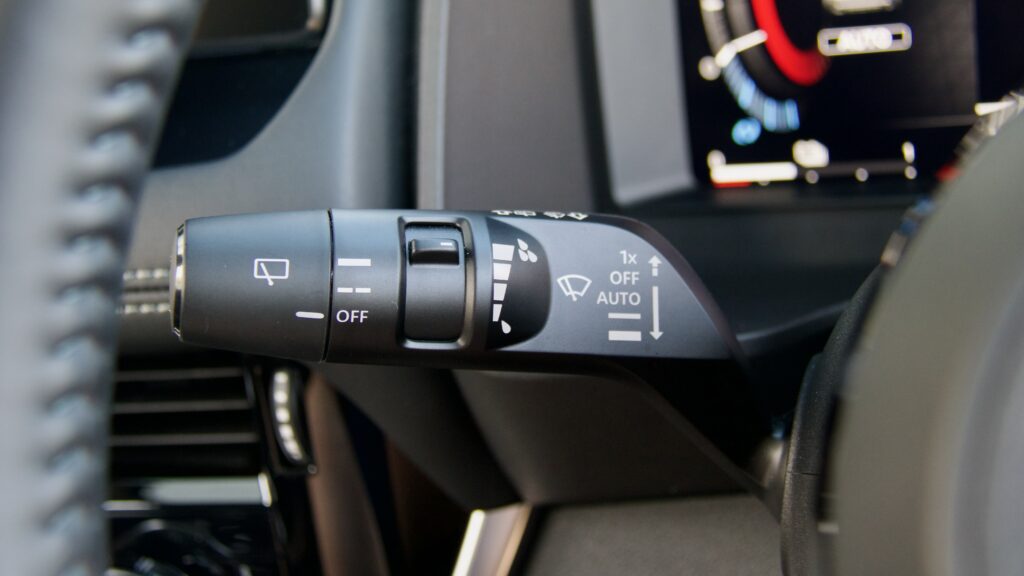
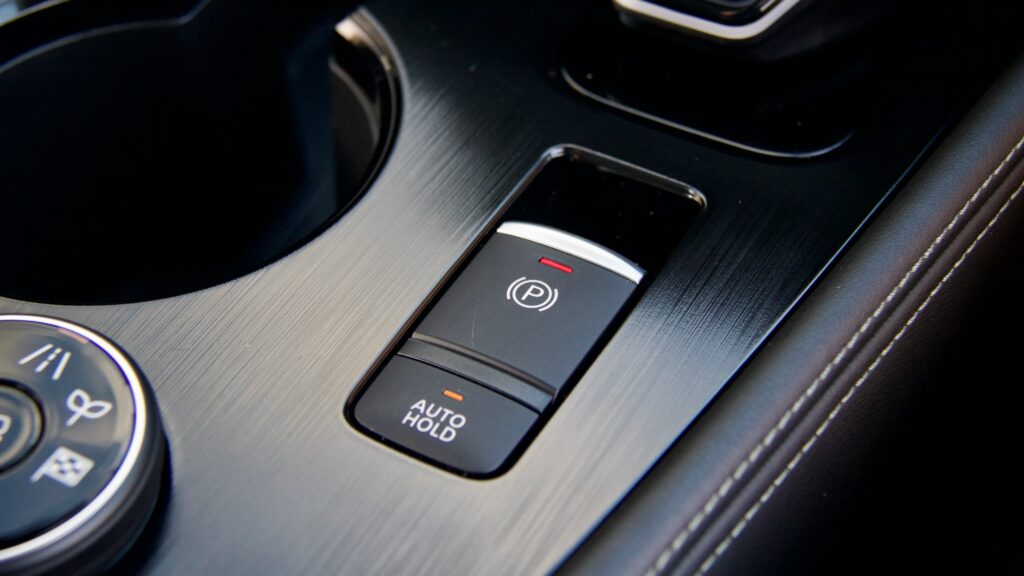
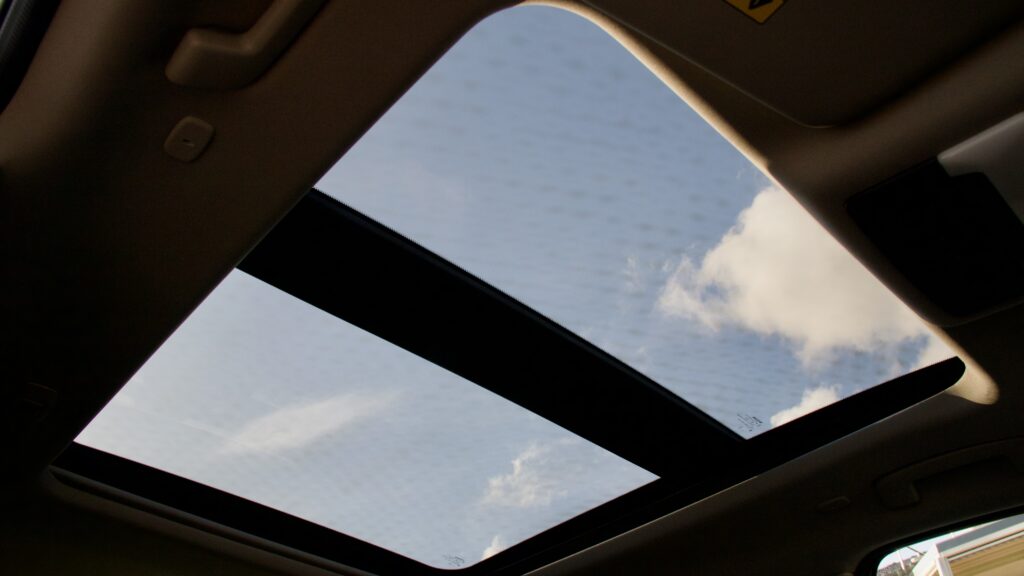
The Toyota RAV4 Cruiser Hybrid AWD undercuts the X-Trail Ti-L e-Power in price, with Toyota charging around $60,000 drive away (depending on location), but the Nissan is better equipped, featuring rear automatic braking, blind spot assistance, a tyre pressure monitoring system, a front centre airbag, a heads up display, a seperate climate zone for the second row, adaptive headlights, a kick sensor for the power tailgate, a larger 12.3 inch screen, an extra speaker for the sound system, a heated steering wheel, larger 20 inch alloys, a larger panoramic sunroof, lumbar adjustment for the front passenger, heated rear outboard seats, and inbuilt rear door shades for the second row. The RAV4 does feature one extra USB charging point, ventilated front seats, connected safety and security features (such as an SOS button, stolen vehicle tracking and control of various functions of the car through a smartphone app) and a driver’s knee airbag over the Nissan.
The Subaru Forester Hybrid S AWD further undercuts the Nissan, costing around $54,600 drive away (depending on location), but is more of a mild hybrid. The Subaru is also missing plenty of equipment which the X-Trail has, including front and rear parking sensors, front cross traffic alert and assistance, traffic sign recognition, front centre airbag, a fully digital instrument cluster (vs a small 4.3 inch driver’s display in the Forrester), a head up display, a third zone of climate control for the rear row, remote engine start, kick sensor powered tailgate, a digital rearview mirror, a larger 12.3 inch touchscreen infotainment system (vs 8.0 inches in the Forrester), wireless Apple CarPlay, a wireless phone charger, two additional speakers, a heated steering wheel, two extra ways of adjustment for the driver and passenger’s seats, heated rear outboard seats, Nappa leather interior (vs standard leather in the Forrester), rear door sunshades, ambient interior lighting larger 20-inch alloy wheels (vs 18-inch in the Forester).
We’d say in the face of the closest competition, the X-Trail represents good value – it has plenty of equipment to justify its extra asking price over the RAV4 and the combination of more equipment and a full hybrid system compared to the more mild system in the Forester justify the price jump in our view.
Performance & Economy: 8.0/10
Nissan’s e-Power hybrid drivetrain pairs a petrol engine to two electric motors with a lithium-ion battery. Unlike most hybrids we tested, which send power to the wheels through a combination of a petrol engine and electric motors, the e-Power purely uses its electric motors to drive the wheels, with no connection between the wheels and the petrol unit. The sole purpose of the 1.5-litre turbocharged petrol engine is to charge the battery and power the electric motor. The front motor produces 150kW of power, and the rear motor produces 100kW of power – Nissan quotes a combined power figure of 157kW. Nissan doesn’t quote a combined torque figure for the electric motors, but the front motor produces 330Nm and the rear motor produces 195Nm.
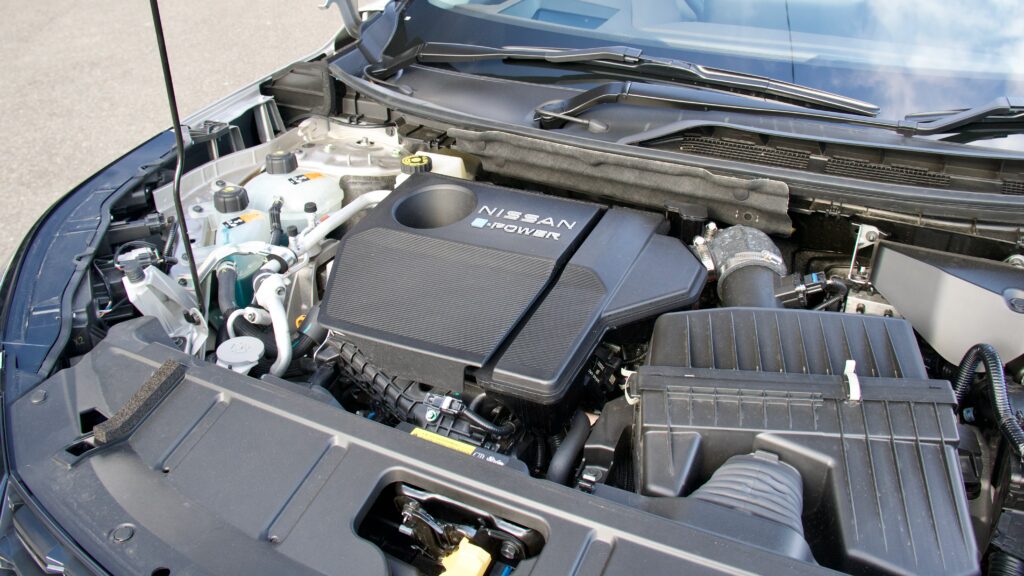
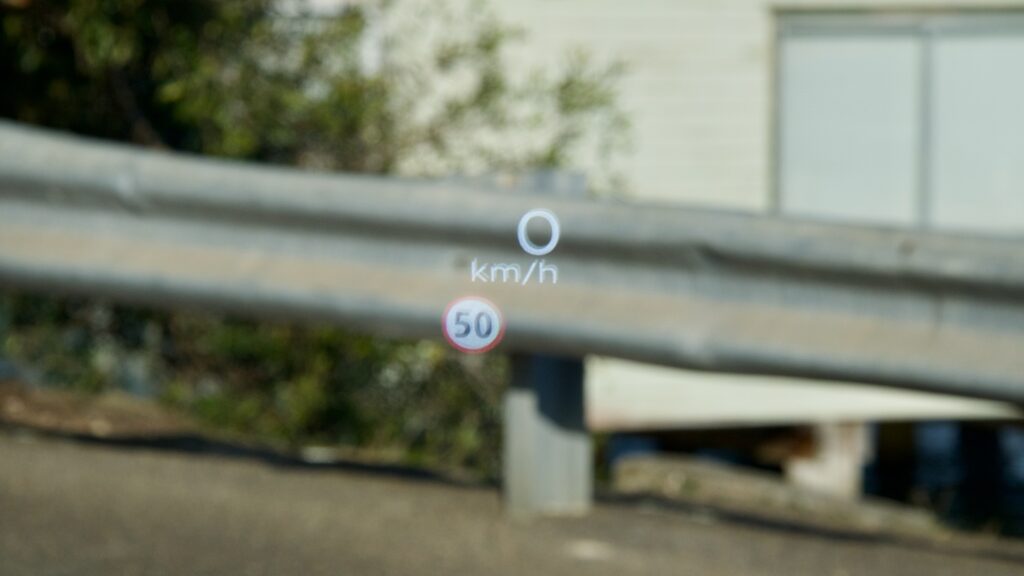
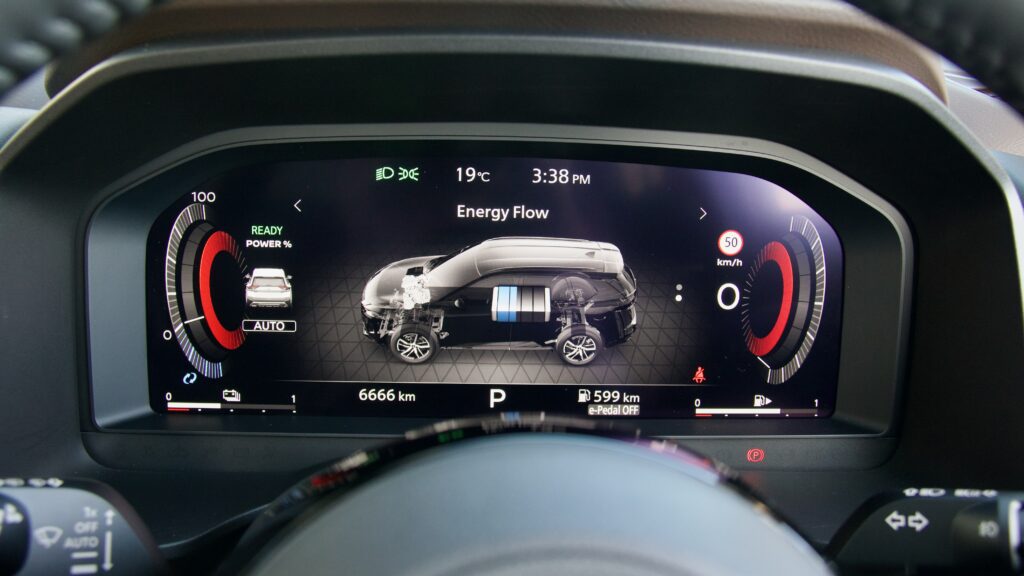
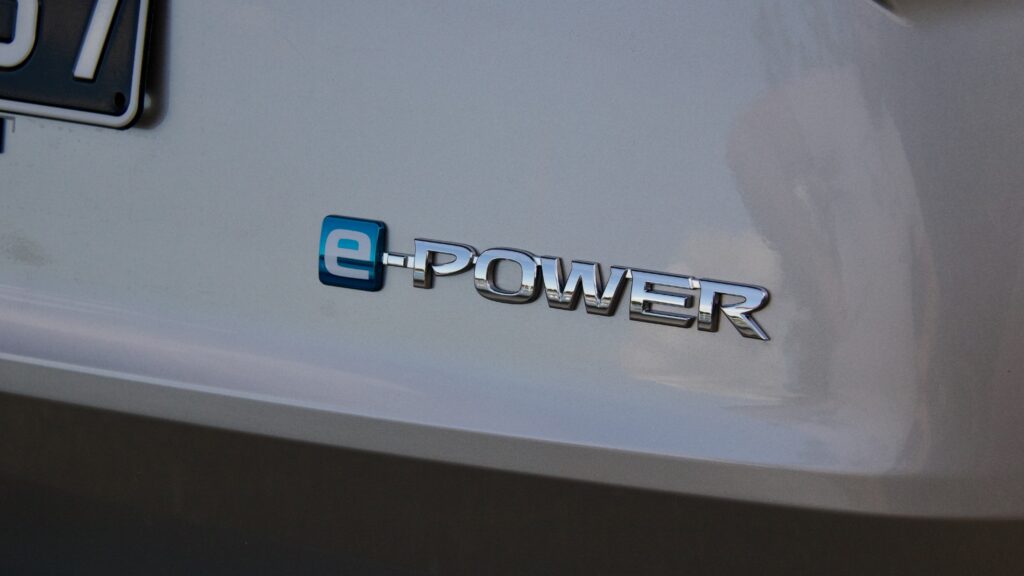
The result of Nissan’s unique hybrid setup is that you’re essentially driving full EV, at least in terms of how the X-Trail performs. It also eliminates the need for a complex transmission to handle constant switching between multiple electric motors and a petrol engine, and the associated lack of refinement this can cause. Instead you get EV-esque smooth and linear acceleration with only the sound of the engine alerting the driver that they’re not in a fully battery-operated EV. The petrol engine is fairly refined when it kicks in, but the sound is noticeable.
The X-Trail is no slouch performance-wise, completing a 0-100 sprint in around 7.3 seconds – it feels equally at home on the highway and overtaking as it does doing suburban duties, getting up to speed with ease and having enough grunt to overtake. Whilst we appreciated the refinement and EV-like qualities of the drivetrain, it does come with a compromise in fuel economy – our week behind the wheel of the X-Trail, with a fairly even mix between suburban and highway driving, returned fuel usage of 6.7 litres per 100kms – not too far off Nissan’s published figure of 6.1 litres per 100kms.
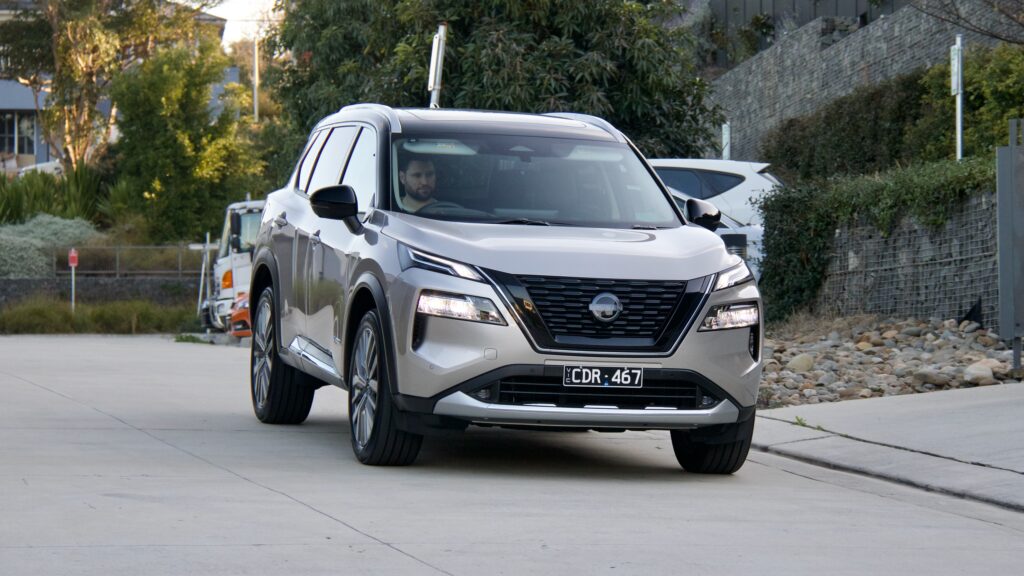
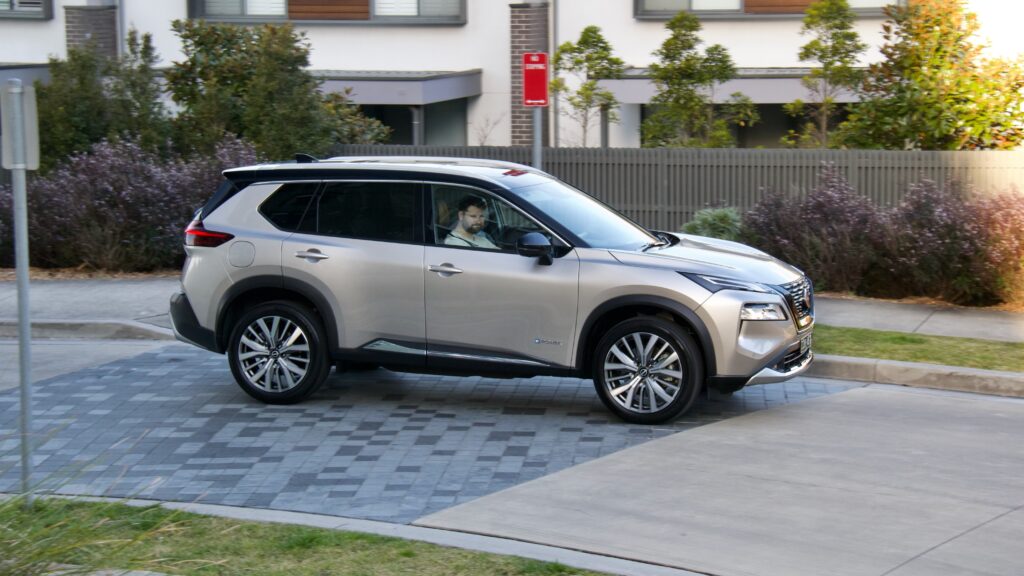
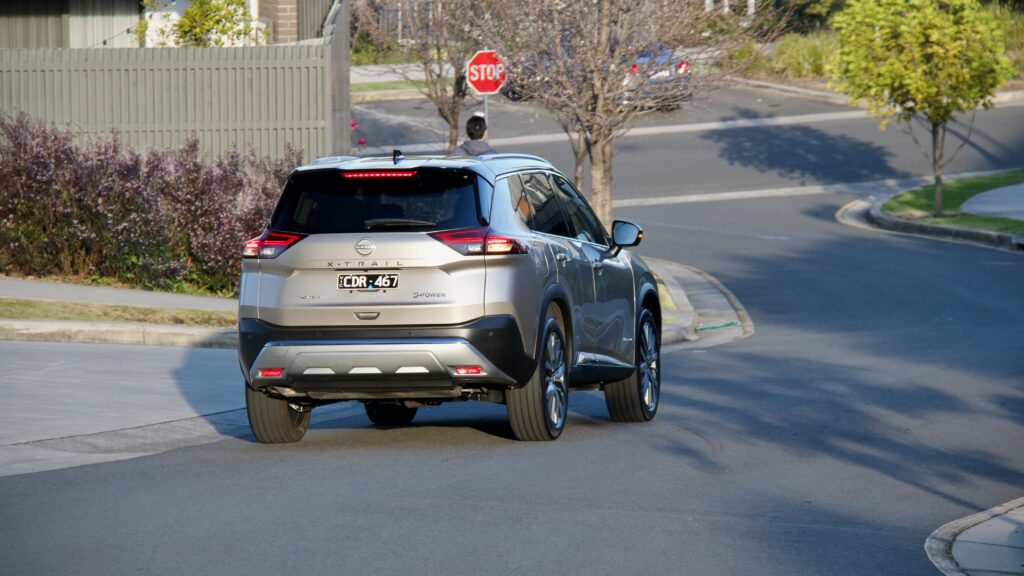
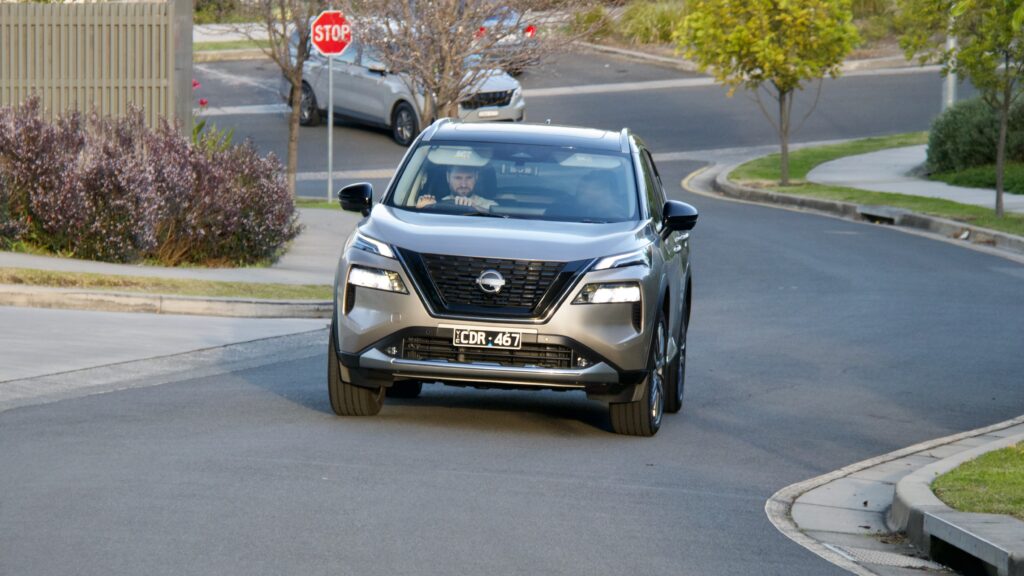
While in isolation the figure we achieved is great for a mid sized SUV, a RAV4 hybrid will easily achieve fuel consumption around the low 5s. We think though it really comes down to preference – whether a buyer wants a more refined EV-like experience or whether the economy is more important. The X-Trail will run on 91RON unleaded fuel, however Nissan recommends the use of 95RON fuel – with a full 55-litre tank and achieving our 6.7-litre per 100km fuel consumption figure, a range of around 820 kms should be achievable.
Ride & Handling: 8/10
The 2023 X-Trail Ti-L e-Power Hybrid features carry-over underpinnings from the last generation, with a ride/handling balance that leans more towards comfort than dynamic ability. We found the steering, while not the first word in feedback, to be reasonably well weighted, fairly direct and light enough to be easily manoeuvrable around town. The X-Trail handles in a predictable and safe manner, which is what most medium SUV drivers will appreciate and expect. Pushing the X-Trail harder through corners causes understeer to rear its head – it’s here that the extra heft of the hybrid battery can be felt – but we doubt many drivers are going to want to be pushing their X-trail hard.
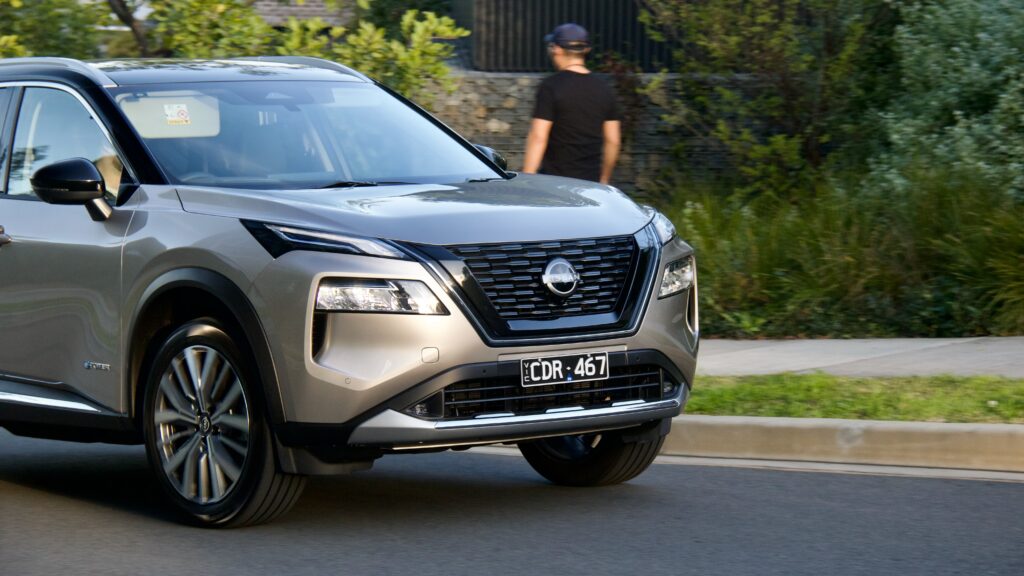
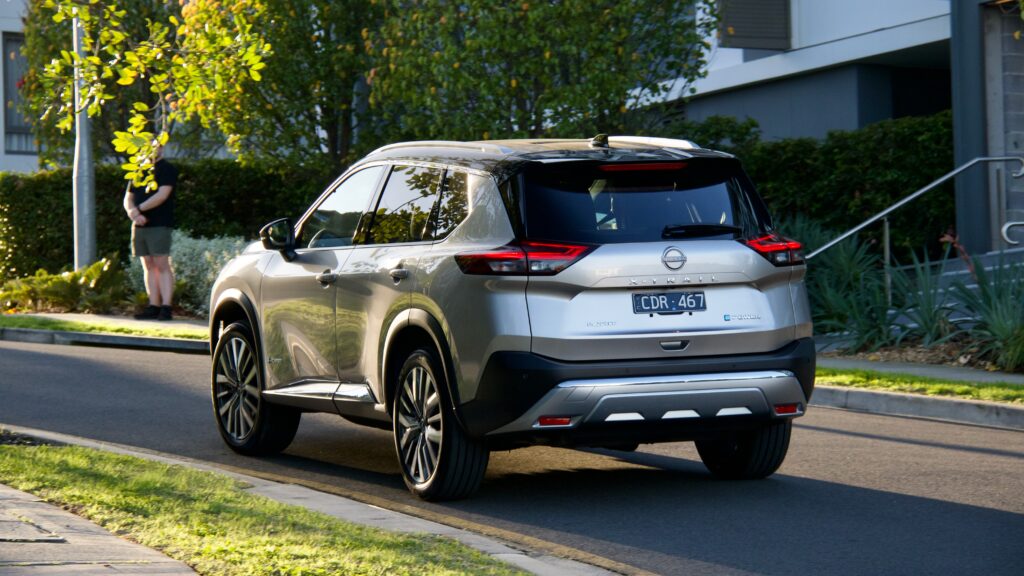
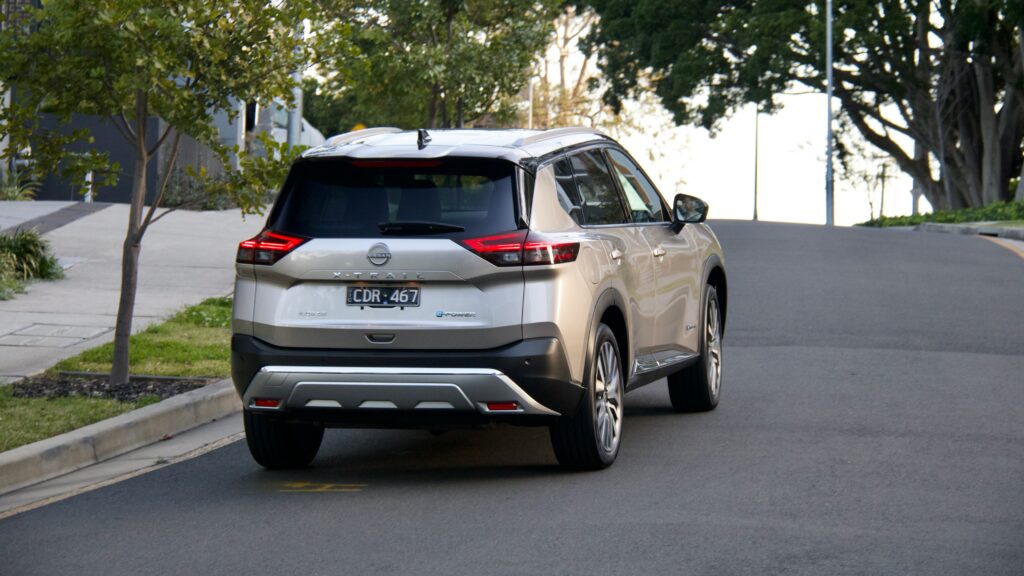
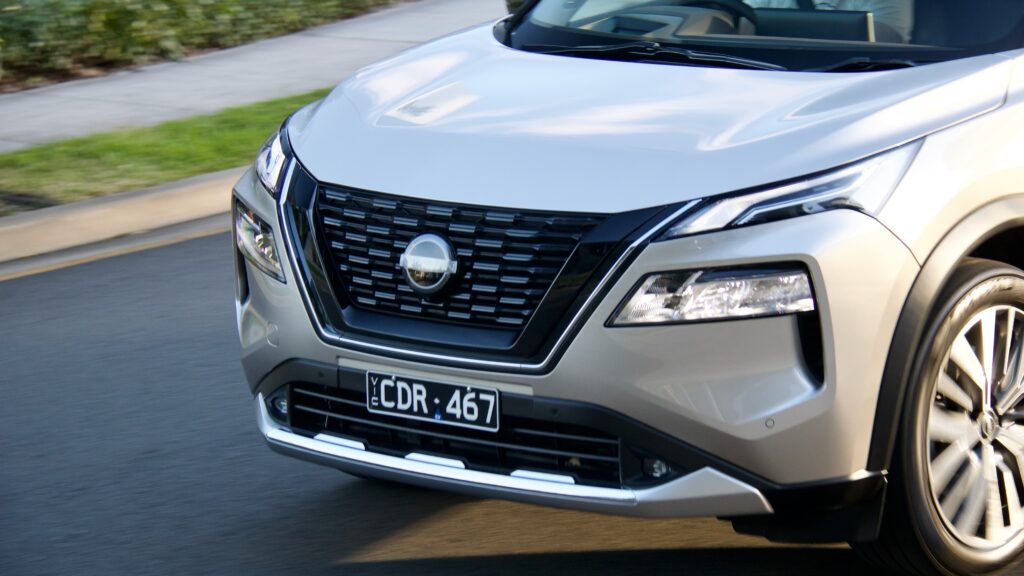
The X-Trail rides well, coping well over a variety of road surfaces and keeping occupants well insulated from the myriad of potholes and surface imperfections that plague Australian roads. For the most part the X-Trail settles promptly after going over bumps, though take it over a speed hump or bigger road imperfections and things remain a tinge rocky – it feels like the suspension setup is definitely tuned for the lower weight of the petrol X-Trail. Road noise is suppressed well, as is wind noise. The X-Trail is still a pleasant place to be even at highway speeds, making it a great touring SUV.
Like (we suspect) many drivers, we didn’t take the our X-Trail off road the week we had with it, so we can’t comment on it’s off road capabilities, but most drivers will be satisfied with the traction benefits the system brings during everyday driving – particularly in the rain. Drivers benefits from good all round visibility, with the high resolution reversing and 360 degree cameras helping out in tight spots.
Interior & Practicality: 9.5/10
Stepping inside the 2023 Nissan X-Trail Ti-L e-Power Hybrid reveals quite the modern and classy feeling space – it’s a definitely a big step up on the cabin of the previous generation in pretty much every single way. Material quality throughout is great, with lashings of soft touch materials covering all the most frequently touched surfaces throughout the interior, including the dashboard, the door cards, the sides of the centre console, the centre armrest, which definitely creates an ambience of quality. The switchgear throughout is also great – they feel premium with good dampening – it’s a night and day difference from the last-gen Nissan controls – we’re happy to see the back of the clunky oval bulge window switches in particular! All the materials feel high in quality and the interior is generally very well served together – it feels like a space that will last well. Contrasting white stitching through a combination real and faux leather in combination with well executed imitation wood inserts through the cabin add interest to the design.
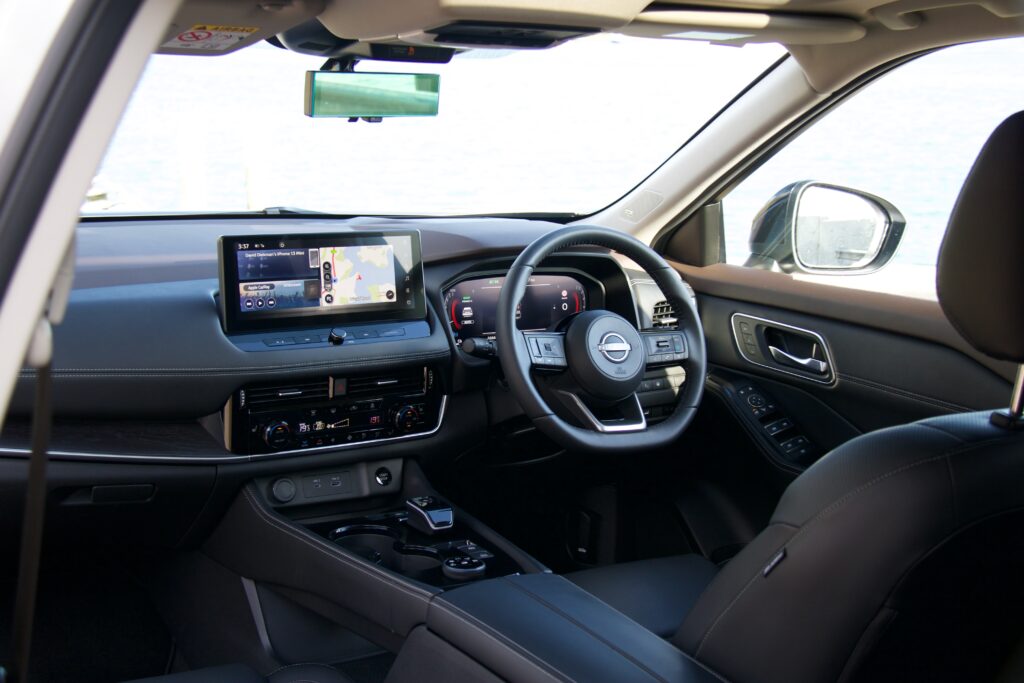
The front seats, covered in a high quality quilted design Nappa leather, are comfortable and supportive with both good bolstering and an excellent range of adjustment – both the driver and passenger have 10 ways of powdered adjustment, making finding a comfortable driving position easy. While unfortunately, ventilated seats are nowhere to be seen, the seat heating will be appreciated by Australians in colder parts of the country, as will the heated steering wheel. Speaking of, the wheel is comfortable in the hand – we appreciated the quality leather wrapping.
The instrument cluster in the X-Trail Ti-L e-Power Hybrid is a fully digitised unit, with a crisp high quality 12.3 inch screen, capable of displaying plenty of useful information, though as with most digital instrument clusters, we wish there was a bit more customisation to decide exactly what content the driver would like to see, rather than being stuck with pre-determined information sets/displays. The driver also has a large 10.8-inch head up display, keeping essential information within eyesight while focusing on the road.
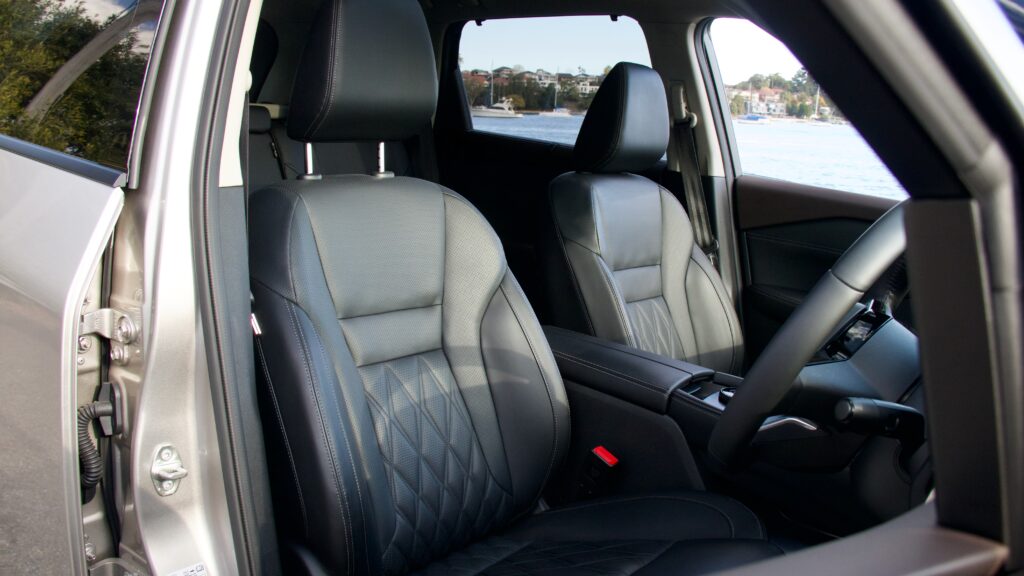
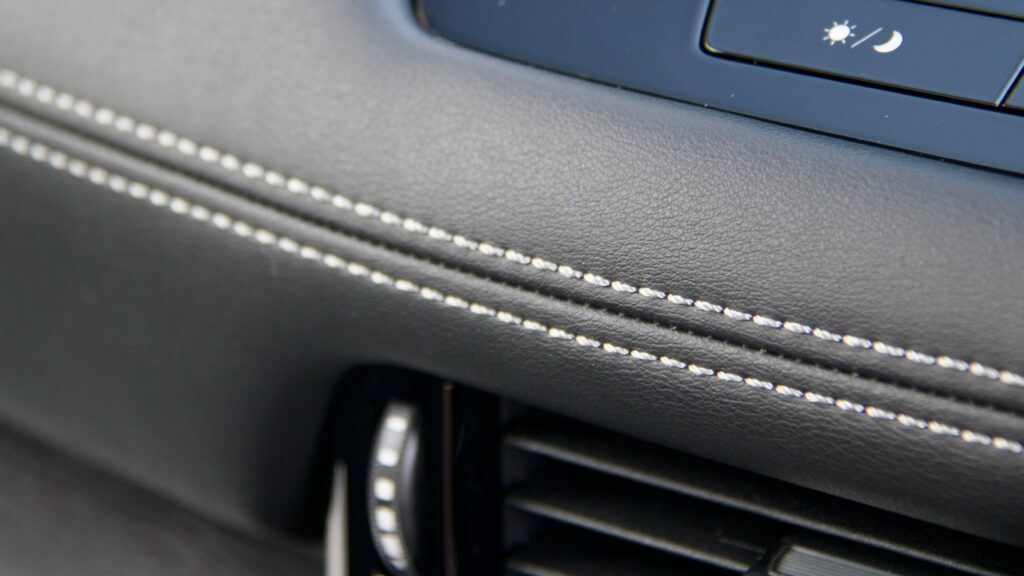
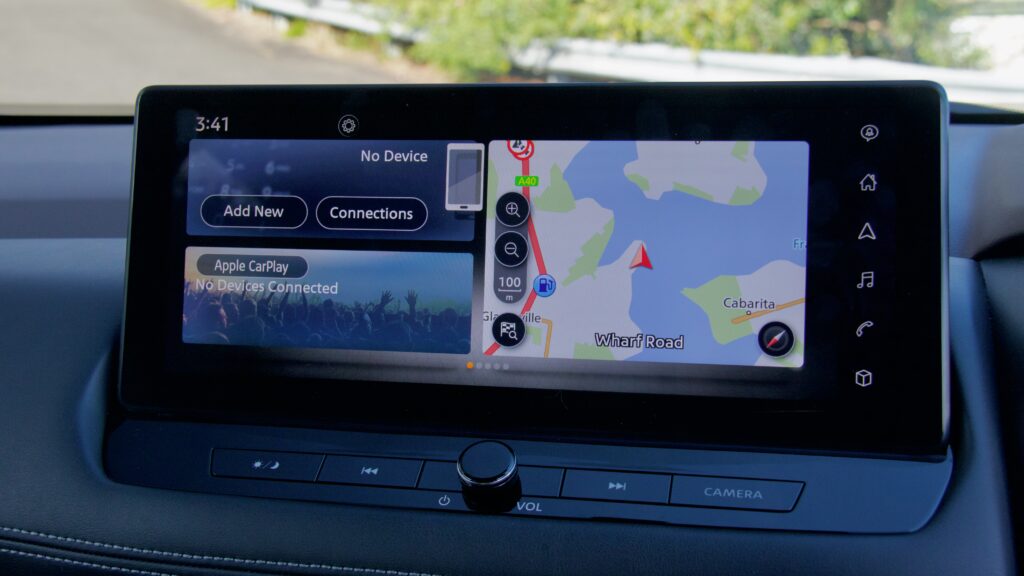
Continuing the theme of large screens is the 12.3-inch touchscreen. Featuring wireless Apple CarPlay, wired Android Auto with the usual AM/FM/DAB+ radio and satellite navigation, we were throughly impressed with the unit, with a high resolution and fluid screen, snappy performance and modern software. Unlike many other wireless Apple CarPlay units that we’ve tested which we’ve encountered all manner of issues with lag and random disconnections, Nissan’s implementation was reliable and solid. We particularly liked the well thought out persistent shortcut controls on the left side of the screen, as well as the physical controls below it, which offer quick and easy ways at getting to important functions, such as the 360 degree camera, or adjusting the volume quickly with a knob. The Bose sound system with 10 speakers had pretty good base and clarity, rendering music well during our testing. Front seat occupants have two USB charging points (one doubling as the input for the infotainment system), in addition to a wireless phone charger.
Storage throughout the cabin is fairly generous, with a big centre console under the armrest, a fairly large glove box, large drink holders in the centre console, good sized door bins, the wireless phone charger cubby under the centre vents and there is a hollow section sitting beneath the floating centre console offering even more storage space. Kudos also to Nissan for resisting the temptation to integrate the climate controls into the infotainment screen – easy and safe to use while driving physical controls are instead used.
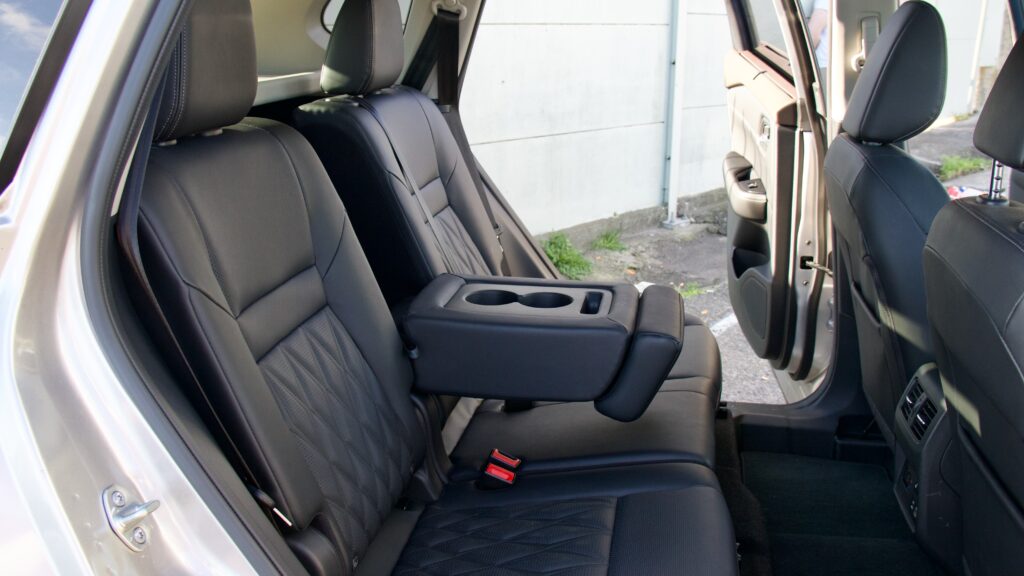
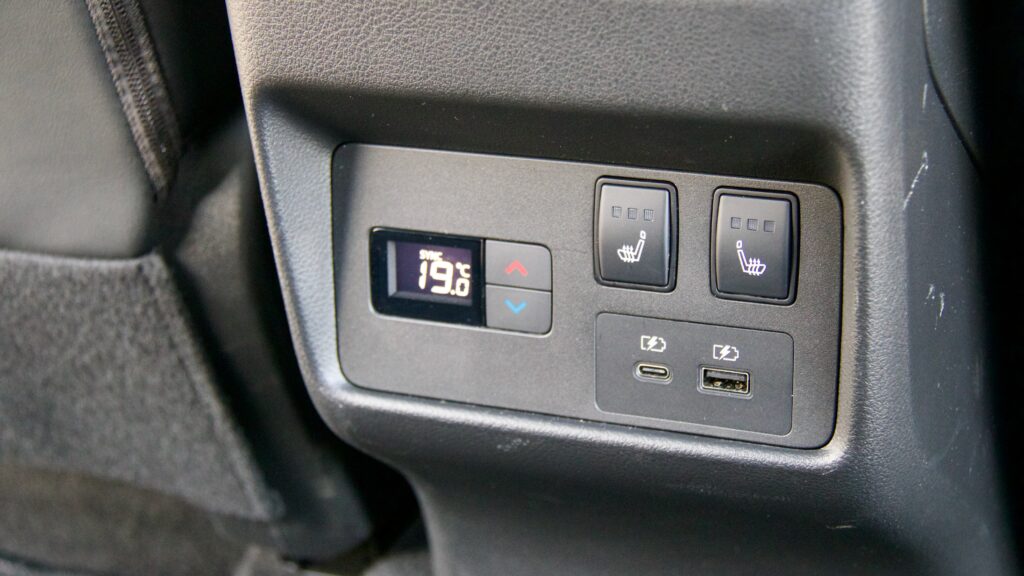
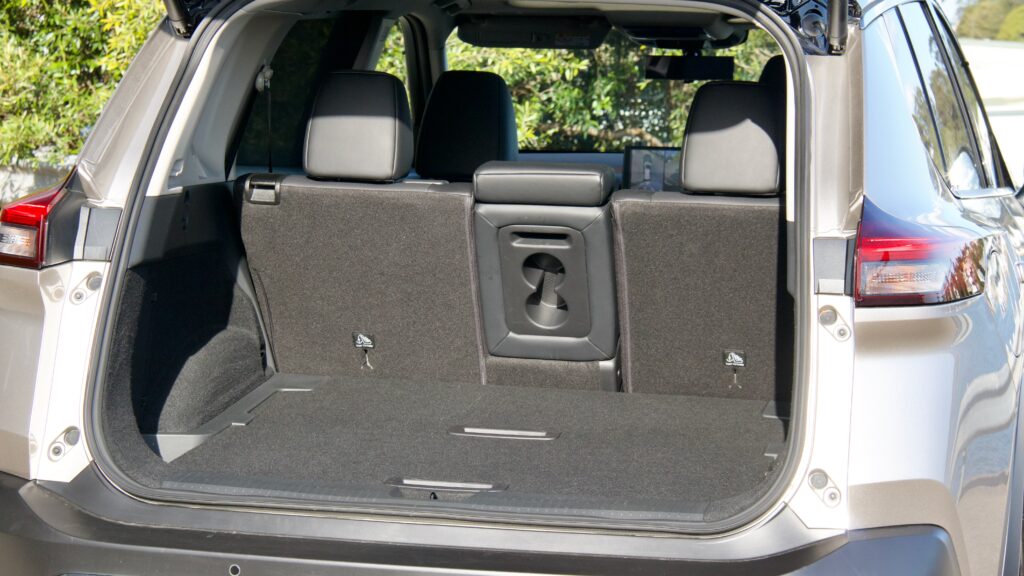
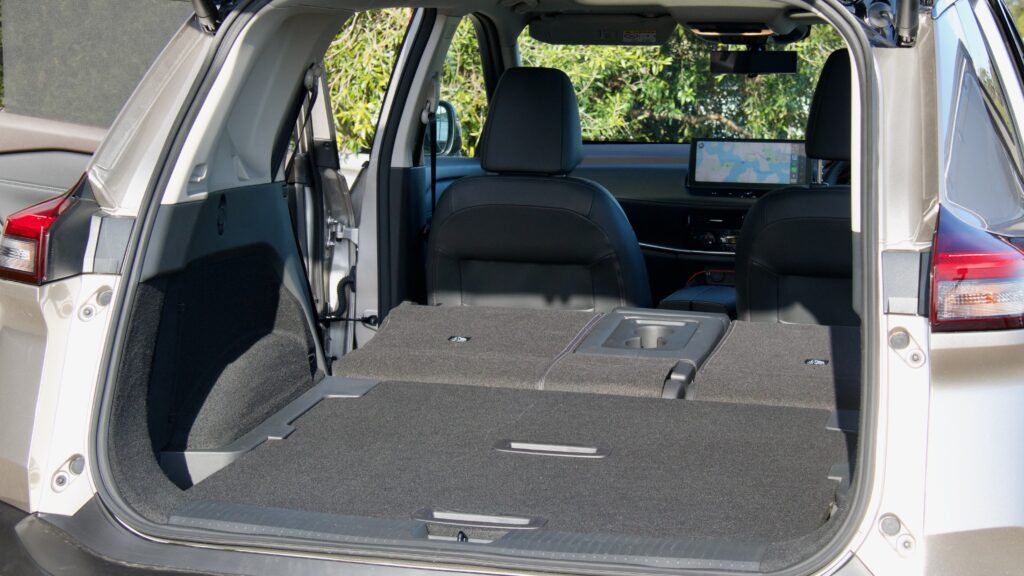
The rear row of the X-Trail is spacious and airy thanks to the panoramic sunroof. There is plenty of space for adults to be comfortable own the outbound seats, with ample head room, leg room and foot room, even for taller occupants. A third adult can also fit in the middle seat without too much discomfort, though it’s better suited to shorter trips. Three children should fit comfortably across the back. In addition to offering plenty of space, the second row is well kitted out. The rear outbound passengers have heated seats, a separate climate control zone for the rear, door sunshades, a centre armrest, door bins with drink holders and two USB charging points – a USB C and USB A port – which counts for a pretty comprehensive list for a mid sized SUV.
Opening the boot reveals a fairly generous 575-litre space – only 5L less than the RAV4 and amongst the largest In class. The second row folds down to create large flat based loading area, though Nissan doesn’t provide a figure for the volume of the expanded space, we do think it is substantial. A false floor provides a small area to hide items out of view. The boot also features what Nissan refers to as a ‘Divide-N-Hide’ system where the floor can moved and used to customise the boot space to different situations – for example it can create compartments to hold precious items in place. Under the boot floor is a tyre repair kit, which is a bit of a let down. We would have liked to have seen at least a space saver spare.
Service & Warranty: 8/10
Nissan sells the 2023 X-Trail X-Trail Ti-L e-Power Hybrid with a five year/unlimited kilometre warranty an eight-year/160,000km warranty for its hybrid battery. Toyota offers the same five year/unlimited kilometre warranty, but offers an additional two years of drivetrain warranty if servicing has been carried out to logbook specifications and a total of 10 years of warranty for the hybrid battery if an annual hybrid battery health check has been carried out. Subaru give the Forester a five year/unlimited kilometre warranty, though with an additional 3 years/160,000km warranty for the hybrid battery.
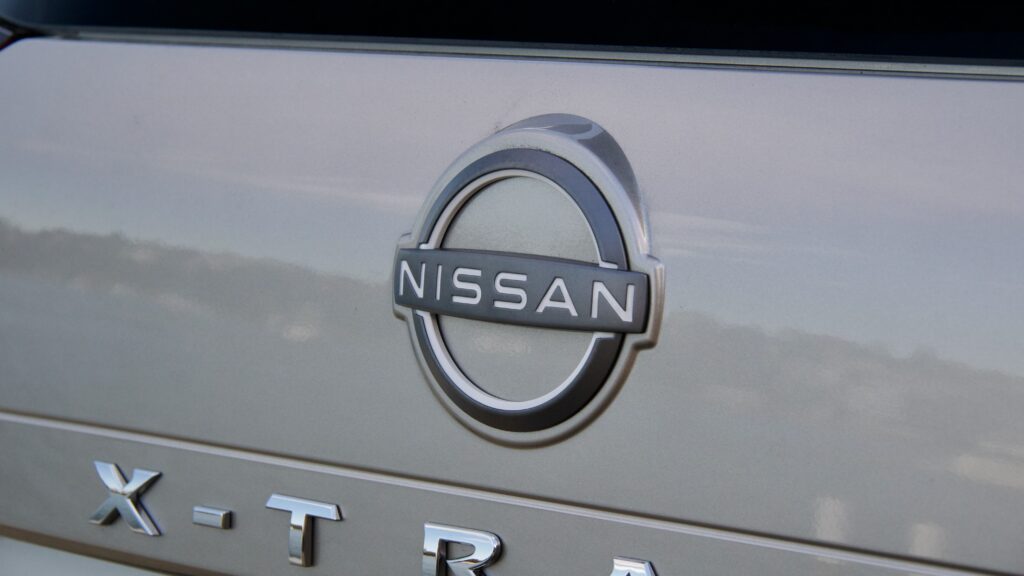
Nissan includes five years of roadside assistance with the X-Trail, which bests Subaru’s 12-month inclusion for the Forester, though Toyota includes none with the RAV4. The X-Trail has 10,000km/12 month service intervals and with its capped price service program, the first five years/50,000km of servicing comes to a total of $2,353 ($470 per service). The Forester has slightly longer 12-month/12,500km service intervals but costs more to service over five years, coming to a rather expensive $2693.61 ($538 per service). The RAV4 has the best service package of the trio, with the longest intervals at 15,000kms/12 months, and the total for the first five years undercutting both the Nissan and Subaru, coming in at just $1300 ($260 per service).
The 2023 Nissan X-Trail Ti-L e-Power Hybrid DiscoverAuto Rating: 8.5/10
We came away from our week with the X-Trail throughly impressed – Nissan has done an excellent job in creating a legitimate challenge to the RAV4 Hybrid, but more than that, a quality mid-sized SUV which can stand on its own as a very compelling car. The 2023 X-Trail Ti-L e-Power Hybrid is reasonably priced with a comprehensive equipment and safety list, and features an interior that ticks all the right boxes. Not only is it practical, comfortable and spacious in the front and rear, but it’s well thought out, with great integration of technology and a feeling of classiness and quality. Nissan’s unique e-Power hybrid system also has some definite benefits over traditional setups, with an EV-esque acceleration and driving feel.
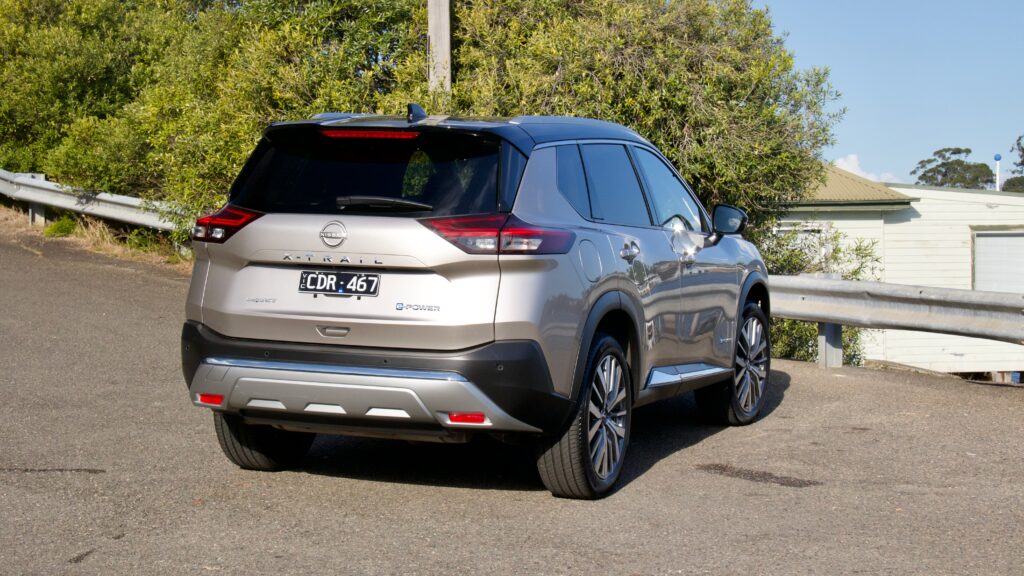
That’s not to say it’s perfect – for all its benefits, the drivetrain isn’t as efficient as the RAV4, it’s not the best in class dynamically and servicing isn’t cheap. However, we think plenty of buyers will be able to overlook these small flaws, and the 2023 X-Trail X-Trail Ti-L e-Power Hybrid is definitely worth a place on your test drive list if you’re in the market for a hybrid mid sized SUV.
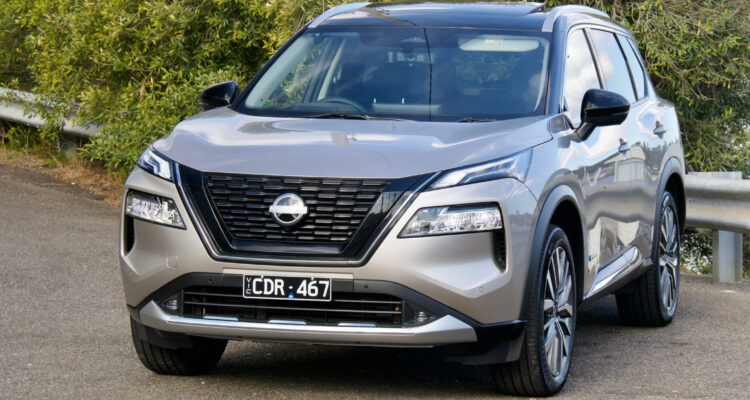
Leave a Reply